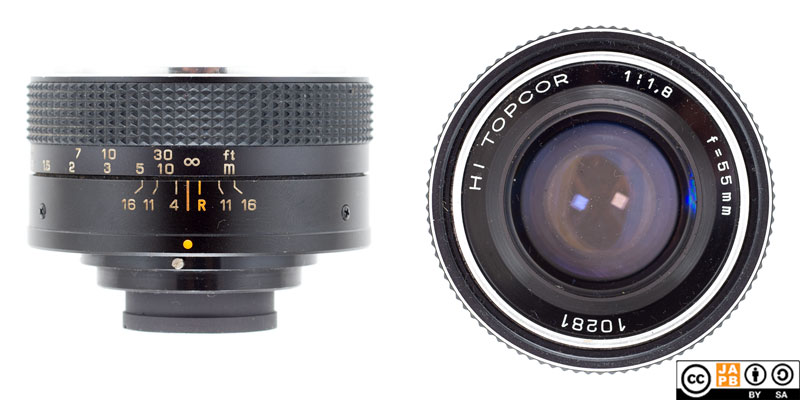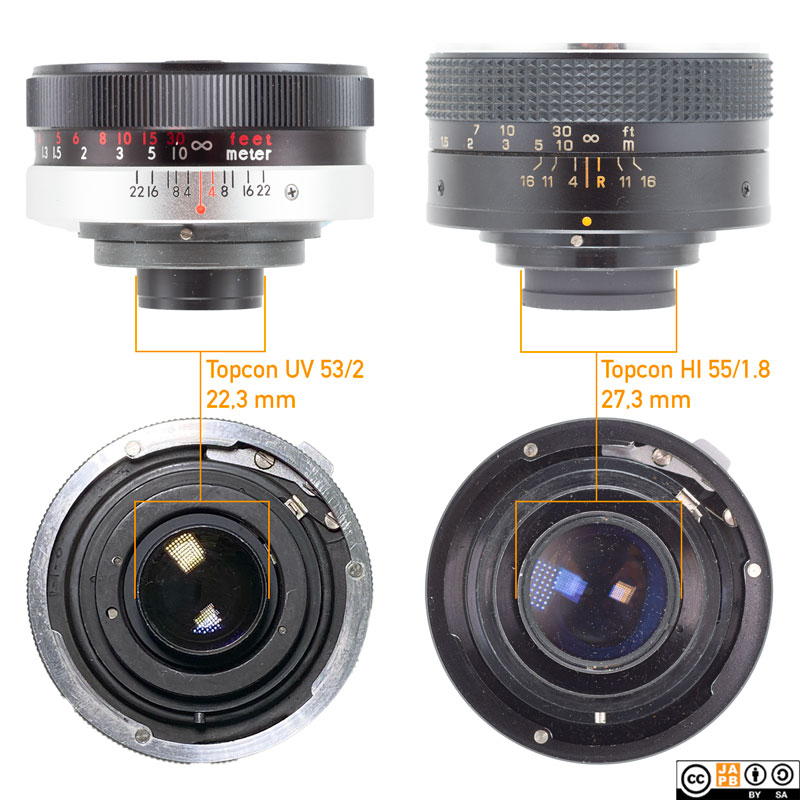Pekka Buttler, 08/2024 (Updated 02/2025)

Specifications
The table below summarizes the lens’ key specifications (measurements based on pictured, last version of the lens):
| Brand: | Tokyo Kogaku (Topcon) | Lens name | HI TOPCOR 1:1,8 f=55mm |
| Focal length(s)1 | 55 mm | Angle-of-view2 | 42,9 ° |
| Maximum Aperture | f/1.8 | In Production | 1976–1978 |
| Lens mount (this lens) | Topcon UV | Generation | Topcon HI |
| Length3 | 31,5 mm | Diameter4 | 60,3 mm |
| Filter ring diameter | 49 mm | Weight | 178 grams |
| Lens element count | 6 | Lens group count | unknown |
| Aperture blades (S/R/C)5 | 5 S | Focus throw | 160 ° |
| Minimum focusing distance | 70 cms | Maximum magnification | 1:10,6 |
| Has manual aperture ring | NO | Has Manual focus ring | YES |
| Aperture mechanism type | N/A | Aperture click stops | N/A |
Further notes:
• This lens was the final nifty fifty for the Topcon UV system. It was introduced in 1976 together with the New IC-1 Auto camera. This lens remained in the lineup until the end of the Topcon UV system.
• As with all Topcon UV lenses, this lens lacks an aperture ring (aperture was controlled on the camera). This has some implications for adapting (see below)
• The filter threads do not rotate on focusing.
About Topcon HI lenses
• In 1973 Topcon introduced the IC-1 Auto (which was replaced in 1976 by the New IC-1 Auto). The IC-1 Auto was the first camera for the Topcon UV system that did not rely on a leaf shutter6 and therefore enabled lenses that were not constricted by the narrow throat diameter (22,7 mm) that the leaf shutter demanded.
• At the same time Topcon started introducing a new sub-series of lenses designed for the IC-1 Auto, and these lenses were named Topcon HI (HI Topcor) in contrast to Topcon UV.
• The following Topcon HI lenses were introduced before discontinuation of the system:
• Topcon HI 87-205mm f/4.7 (introduced 1973/74)
• Topcon HI 50 mm f/2 [data sheet] (introduced 1973/74)
• Topcon HI 50 mm f/2.8 [data sheet] (introduced 1976)
• Topcon HI 55 mm f/1.8 (this lens) (introduced 1976)
• Topcon HI lenses are a subclass of the Topcon UV lenses in that their physical mount and lens-body communication are identical, but in terms of compatibility there is a quirk: While Topcon UV lenses can (without restrictions) be used on all Topcon UV bodies (from the 1963 Wink Mirror S to the 1976 New IC-1 Auto), some Topcon HI lenses were compatible only with the 1973 IC-1 Auto and the 1976 New IC-1 Auto). The lenses that do not fit the leaf shutter designs are the Topcon HI 87-205 mm zoom and the Topcon HI 55 mm f/1.8. The key difference can be illustrated with the picture below:

• The two other Topcon HI lenses: The Topcon HI 50 mm f/2 and the Topcon HI 50 mm f/2.8 (which replaced the Topcon UV 50/2 and Topcon UV 50/2.8 respectively) actually do fit within the throat/leaf shutter mechanism of all the Topcon UV cameras I have tested7.
• While it is not explicitly mentioned anywhere, JAPB’s conjecture is that Topcon had in the early 70s embarked on a general redesigning of their lineup of lenses for the UV system and had decided to call their new generation of lenses HI (and that this redesigning was simply cut short by Topcon’s 1978 decision to withdraw from making cameras).
Versions and variations
The original nifty fifty for the Topcon UV system was the 53 mm f/2 Topcon UV lens [data sheet], which was introduced together with Wink Mirror S camera in 1963. That design was replaced as the nifty fifty in 1969 by the 50 mm f/2 Topcon UV lens [data sheet], which was in turn was replaced in 1973/1974 with the Topcon HI 50 mm f/2 .
This lens, the Topcon HI 55 mm f/1.8 was the last iteration of the Topcon UV system’s nifty fifty and was technically the brightest lens produced for the Topcon UV system.
Seemingly, there is only one version of this lens.
History of Topcon
Unless you know your camera lore, you might not know that Topcon was once – between 1957 and 1976 – one of the foremost camera companies in the world.
You can read more details in the Topcon company profile.
Adapting
Adapting Topcon UV lenses is not especially easy, but this is not so much due to the lens mount. Technically the Topcon UV mount is very much like the DKL mount, and adapters for the DKL mount have existed for ages. Moreover, the Topcon UV mount offers a generous flange focal distance, making it relatively easy to manufacture adapters, even to SLR mounts.
The real reason why adapting Topcon UV lenses is relatively difficult is the simple weak availability of suitable adapters. It seems practically no-one bothered manufacturing adapters to allow the use of Topcon UV lenses on SLRs, and even with today’s most popular mirrorless mounts, you have to dig deep into aliexpress to find a metal adapter from Topcon UV to Sony FE/NEX (eBay has some 3D printed adapters).
(Remember that because Topcon UV lenses lack an aperture ring, that is a functionality that the adapter must supply.)
With these limitations in mind, below are (in the current state of affairs) the situation for adapting Topcon UV lenses.
This lens cannot be used natively on any current SLR or dSLRs. To use it in its native environment, you will need a Topcon IC-1 auto or new IC-1 auto8 film body. While these were never produced in immense numbers, they seem to have stood the test of time reasonably well, and can still be found in a functioning condition.
While Topcon UV lenses are manual focus lenses, they lack an aperture ring. Hence, to adapt a Topcon UV lens to a mirrorless camera, you need an adapter that not only offers the correct mounting system and flange focal distance, but also allows you to control the Topcon UV lens’ aperture mechanism. As noted above, such adapters are available, but their availability is surprisingly weak. No special adapters (helicoid adapters, tilt/shift adapters) are currently available.
Using Topcon UV mount lenses on an SLR/dSLRs could be an option (there are no physical reasons why the mount could not be adapted), and Topcon themselves used to offer an adapter allowing the mounting of Topcon UV lenses on Topcon RE cameras. However, it seems that there are currently no adapters available. Moreover, as the rearmost element of many Topcon UV lenses protrudes significantly beyond the flange, it is not inconceivable that some Topcon UV lenses would (assuming there was an adapter) risk colliding with the mirrors on some dSLRs.
Footnotes
- Focal length is (unless stated otherwise) given in absolute terms, and not in Full-frame equivalent. For an understanding of whether the lens is wide/tele, see ‘Angle-of-view’. ↩︎
- Picture angle is given in degrees (based on manufacturers’ specs) and concerns the diagonal picture angle. Rule of thumb:
> 90 ° ==> Ultra-wide-angle
70–90 ° ==> Wide-angle
50–70 ° ==> Moderate wide-angle
40–50 ° ==> ‘Standard’ or ‘normal’ lens
20–40 ° ==> Short tele lens
10-20 ° ==> Tele lens
5-10 ° ==> Long tele lens
< 5 ° ==> Ultra-tele lens ↩︎ - Length is given from the mount flange to the front of lens at infinity. ↩︎
- Diameter excludes protrusions such as rabbit ears or stop-down levers. ↩︎
- S=straight; R=rounded; C=(almost)circular at all apertures. ↩︎
- Topcon’s parter Seikosha had decided to end production of the leaf shutters earlier Topcon UV cameras (Wink Mirror S, Uni, Unirex, Unirex EE) had depended on. ↩︎
- Which are all but the Wink Mirror S. ↩︎
- Older Topcon UV bodies (Wink Mirror S, Uni, Unirex) will not be able to fit this lens’ rear element. ↩︎